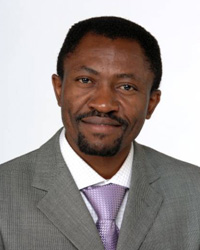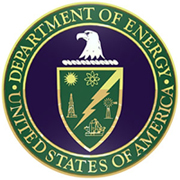 Merlin Ngachin (Physics) About DOE Fellow:
Merlin is an IAEA Certified Radiation Protection Adviser (RPA). He worked with the Italian Regional Agency for Environmental Protection (ARPA-FVG) in Italy on projects related to radon measurements in different matrices. He has implemented methods for soil radon measurement and radon exhalation rates in materials used for construction and decoration. Merlin co-authored several papers in the field of Environmental Health Physics. He has knowledge in Radiation Dosimetry, Radiation Protection and safe use of Radiation Sources. |
| DOE Related Projects |
Recently, Merlin has finished working on a project which aims at selecting puncture-resistance materials for the protection of beta scintillation detectors. An experiment was performed to test materials that could be used to protect the Mylar film of the Ludlum beta detector (used for radiological surveys around the Hanford Site) from punctures. The properties of the candidate materials were understood based on the physics of interaction of radiation with matter.
Merlin is currently involved in a project which tests a new technology, namely SIMWyPES®, developed by Babcock & Wilcox and used at the Y-12 National Complex at Oak Ridge National Laboratory (ORNL). The objective of the project is to evaluate the performance of the innovative technology in removing loose contamination from contaminated dry surfaces. Experimental results with the SIMWyPES® technology compared to baseline technologies have been obtained using fluorescent powder and uranium oxide (U3O8). The two different technologies (SIMWyPES® vs. Scott Multifold towels) were tested and compared using fluorescent powder as the contaminant on three types of surfaces (Plastic, Formica, and Ceramic). In addition, SIMWyPES® 3% and 6% versus a baseline technology (Chicopee-Masslin) were investigated in decontaminating (U3O8) powder deposited on 5 different surfaces (plastic, Formica, ceramic, stainless steel, and coated concrete).
An abstract of this work was presented at the 54th Meeting of the Health Physics Society held in Minneapolis (July 12-16, 2009). http://hpschapters.org/2009AM/program/singlesession.php3?sessid=P
In Summer 2008, Merlin completed an internship with the Pacific Northwest National Laboratory where he worked on a project aimed at determining the radiation hazard to the US population due to terrestrial sources of radiation. An abstract has been submitted to the 54th Meeting of the Health Physics Society to be held in Minneapolis (July 12-16, 2009)http://hpschapters.org/2009AM/program/singlesession.php3?sessid=WAM-A and a publication is being prepared to be submitted to Health Physics.
A new proposal using Tc-99m is in process of being submitted to test the SIMWyPES®. The scope of the new proposal is to take Tc-99m and label it with particles of different sizes. This will facilitate the evaluation of the SIMWyPES® at different particles size. Furthermore, the present proposal plans to test the SIMWyPES® on surfaces with different smoothness, (from very smooth such as plastic to more rough such as concrete), and then characterize the interactions of the particles of different sizes with the various surfaces, which would suggest that the SIMWyPES technology potentially has a broad application.
More recently Merlin has joined the research group working on environmental remediation. He will be participating in the development of Lattice Boltzmann code for multiphase flow modeling, to be used for Radioactive Waste Management.
| Photos: |

Glove box where the evaluation with uranium oxide was conducted

E600 Eberline alpha-beta detector

